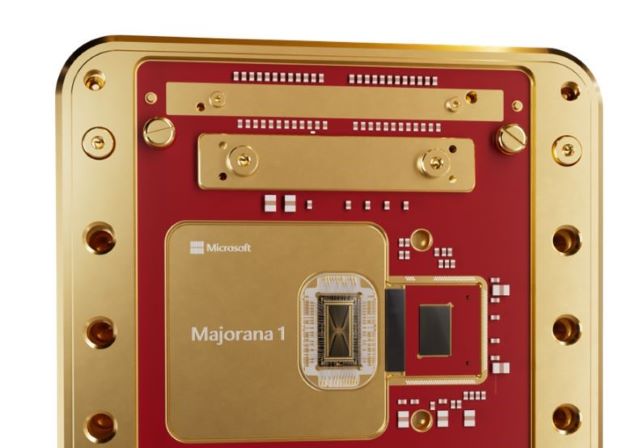
The 2025 International Year of Quantum Science and Technology marks the 100th anniversary of the initial development of quantum mechanics. Established by the United Nations, this observance emphasizes quantum science’s contributions and practical applications.
Quantum Computing Day is celebrated annually on April 14, also known as “World Quantum Day.” This date is significant because “4.14” represents the first few digits of Planck’s constant, a fundamental value in quantum mechanics.
Microsoft has now entered the competition to develop chips for quantum computers, signaling that quantum computing is becoming a reality rather than a distant prospect.
On Wednesday, February 19, Satya Nadella, Chairman and CEO of Microsoft, announced a significant breakthrough in quantum computing.
In his LinkedIn post, Nadella stated that this advancement will allow the company to produce “a significant quantum computer not in decades, as some have predicted, but in years.”
According to the official Microsoft blog, the Majorana 1 processor will be capable of addressing industrial-scale problems.
It uses the world’s first topological conductor—a revolutionary material that can detect and manipulate Majorana particles—leading to more reliable and scalable qubits, which are the fundamental building blocks of quantum computers.
As semiconductors enabled the development of modern smartphones, computers, and electronics, topological conductors and the new type of chip facilitate a pathway for creating quantum systems capable of scaling to a million qubits.
These systems are anticipated to tackle some of the most complex industrial and societal challenges.
Microsoft also mentioned that the new architecture developed for the Majorana 1 processor offers a clear pathway to fitting a million qubits onto a chip small enough to be held in one hand.
Achieving this milestone is essential for quantum computers to deliver transformative, real-world solutions, such as breaking down microplastics into harmless byproducts or creating self-healing materials for industries like construction, manufacturing, and healthcare.
Topological conductors, or topological superconductors, represent a unique category of materials that can create a new state of matter—not a solid, liquid, or gas, but a topological state.
This state allows for producing more stable qubits that are fast, compact, and can be digitally controlled without the compromises required by current alternatives.
Microsoft is now one of only two companies invited to progress to the final phase of DARPA’s Underexplored Systems for Utility-Scale Quantum Computing (US2QC) program.
This initiative is part of DARPA’s larger Quantum Benchmarking Initiative. It aims to create the industry’s first utility-scale, fault-tolerant quantum computer that provides more computational value than costs.
Besides developing its quantum hardware, Microsoft has partnered with Quantinuum and Atom Computing to achieve scientific and engineering breakthroughs with current qubits.
They announced the industry’s first reliable quantum computer last year.
These machines present significant opportunities to enhance quantum skills, build hybrid applications, and foster discoveries, mainly as AI integrates with new quantum systems powered by more dependable qubits.
Azure Quantum offers integrated solutions that enable customers to leverage leading AI, high-performance computing, and quantum platforms within Azure.
This collaboration aims to advance scientific discovery and tackle complex chemistry questions, such as understanding why materials experience corrosion or cracks.
The insights gained could lead to the development of self-healing materials capable of repairing cracks in bridges, airplane parts, shattered phone screens, or scratched car doors.
Quantum computing has the potential to allow engineers, scientists, and companies to design products accurately on the first attempt, which would be transformative across various fields, from healthcare to product development.
The combination of quantum computing and AI tools would enable users to describe the type of new material or molecule they wish to create in simple terms and receive immediate, practical solutions.
Just as the invention of semiconductors made modern smartphones, computers, and electronics possible, advancements in top conductors and the new types of chips they facilitate offer a pathway toward developing scalable quantum systems that can address the most complex industrial and societal challenges.
Quantum computing could also calculate the properties of catalysts that break down pollutants into valuable byproducts or help develop non-toxic alternatives.
Additionally, enzymes, which act as biological catalysts, could be used more effectively in healthcare and agriculture through precise calculations about their behavior, something only quantum computing can provide.
This might lead to breakthroughs that help eradicate global hunger, such as improving soil fertility to increase crop yields or promoting sustainable food growth in harsh climates.
A breakthrough in quantum computing. Majorana 1 brings us closer to harnessing millions of potential qubits working together to solve the unsolvable—from new medicines to revolutionary materials—all on a single chip. #QuantumComputing #QuantumReady https://t.co/mpj8VwEQj0 pic.twitter.com/zlQoyoFURv
— Microsoft (@Microsoft) February 19, 2025
A couple reflections on the quantum computing breakthrough we just announced…
Most of us grew up learning there are three main types of matter that matter: solid, liquid, and gas. Today, that changed.
After a nearly 20-year pursuit, we’ve created an entirely new state of… pic.twitter.com/Vp4sxMHNjc
— Satya Nadella (@satyanadella) February 19, 2025
The U.S. Army Corps of Engineers has been tasked with…
Brown and Caldwell, a leading environmental engineering and construction firm,…
Humboldt State University, one of four campuses within the California…